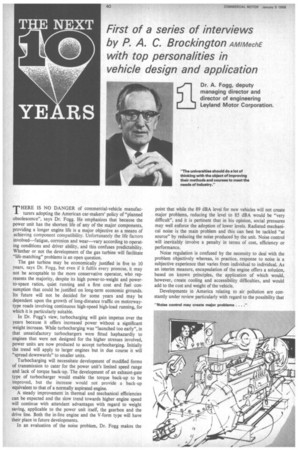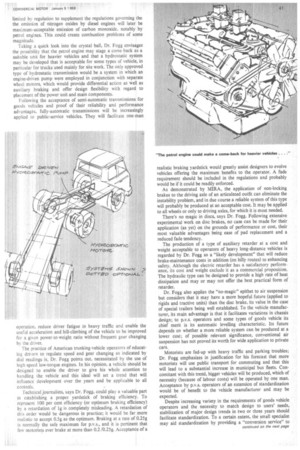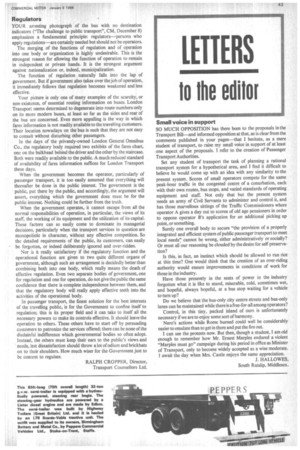First of a series of interviews by P. A. C. Brockington AMIMechE
Page 42

Page 43

Page 44

Page 45

If you've noticed an error in this article please click here to report it so we can fix it.
with top personalities in vehicle design and application
Dr. A. Fogg, deputy managing director and director of engineering Leyland Motor Corporation.
THERE IS NO DANGER of commercial-vehicle manufacturers adopting the American car-makers' policy of "planned obsolescence", says Dr. Fogg. He emphasizes that because the power unit has the shortest life of any of the major components, providing a longer engine life is a major objective as a means of achieving component compatibility. Unfortunately the life factors involved—fatigue, corrosion and wear—vary according to operating conditions and driver ability, and this confuses predictability. Whether or not the development of the gas turbine will facilitate "life-matching" problems is an open question.
The gas turbine may be economically justified in five to 10 years, says Dr. Fogg, but even if it fulfils every promise, it may not be acceptable to the more conservative operator, who represents the majority, despite its high power-to-weight and powerto-space ratios, quiet running and a first cost and fuel consumption that could be justified on long-term economic grounds. Its future will not be decided for some years and may be dependent upon the growth of long-distance traffic on motorwaytype roads involving continuous high-speed high-load running, for which it is particularly suitable.
In Dr. Fogg's view, turbocharging will gain impetus over the years because it offers increased power without a significant weight increase. While turbocharging was "launched too early", in that unsatisfactory turbochargers were fitted haphazardly to engines that were not designed for the higher stresses involved, power units are now produced to accept turbocharging. Initially the trend will apply to larger engines but in due course it will "spread downwards" to smaller units.
Turbocharging will necessitate development of modified forms of transmission to cater for the power unit's limited speed range and lack of torque back-up. The development of an exhaust-gate type of turbocharger would enable the torque back-up to be improved, but the increase would not provide a back-up equivalent to that of a normally aspirated engine.
A steady improvement in thermal and mechanical efficiencies can be expected and the slow trend towards higher engine speed will continue with attendant advantages with regard to weight saving, applicable to the power unit itself, the gearbox and the drive line. Both the in-line engine and the V-form type will have their place in future developments.
In an evaluation of the noise problem, Dr. Fogg makes the point that while the 89 dBA level for new vehicles will not create major problems, reducing the level to 85 dBA would be "very difficult", and it is pertinent that in his opinion, social pressures may well enforce the adoption of lower levels. Radiated mechanical noise is the main problem and this can best be tackled "at source" by reducing the noise produced by the unit. Noise control will inevitably involve a penalty in terms of cost, efficiency or performance.
Noise regulation is confused by the necessity to deal with the problem objectively whereas, in practice, response to noise is a subjective experience that varies from individual to individual. As an interim measure, encapsulation of the engine offers a solution, based on known principles, the application of which would, however, create cooling and accessibility difficulties, and would add to the cost and weight of the vehicle.
Developments in America relating to air pollution are constantly under review particularly with regard to the possibility that limited by regulation to supplement the regulations governing the the emission of nitrogen oxides by diesel engines will later be maximum-acceptable emission of carbon monoxide, notably by petrol engines. This could create combustion problems of some magnitude.
Taking a quick look into the crystal ball, Dr. Fogg envisages the possibility that the petrol engine may stage a come-back as a suitable unit for heavier vehicles and that a hydrostatic system may be developed that is acceptable for some types of vehicle, in particular for trucks used mainly for site work. The only approved type of hydrostatic transmission would be a system in which an engine-driven pump were employed in conjunction with separate wheel motors, which would provide differential action as well as auxiliary braking and offer design flexibility with regard to placement of the power unit and main components.
Following the acceptance of semi-automatic transmissions for goods vehicles and proof of their reliability and performance advantages, fully-automatic transmissions will be increasingly applied to public-service vehicles. They will facilitate one-man operation, reduce driver fatigue in heavy traffic and enable the useful acceleration and hill-climbing of the vehicle to be improved for a given power-to-weight ratio without frequent gear changing by the driver.
The practice of American trunking-vehicle operators of educating drivers to regulate speed and gear changing as indicated by dial readings is, Dr. Fogg points out, necessitated by the use of high-speed low-torque engines. In his opinion, a vehicle shotild be designed to enable the driver to give his whole attention to handling the vehicle and this ideal will set a trend that will influence development over the years and be applicable to all controls.
Technical journalists, says Dr. Fogg, could play a valuable part in establishing a proper yardstick of braking efficiency. To represent 100 per cent efficiency (or optimum braking efficiency) by a retardation of lg is completely misleading. A retardation of this order would be dangerous in practice; it would be far more realistic to accept 0.5g as the optimum. Braking at a rate of 0.25g is normally the safe maximum for p.v.s., and it is pertinent that few motorists ever brake at more than 0.2 /0.25g. Acceptancle of a
realistic braking yardstick would greatly assist designers to evolve vehicles offering the maximum benefits to the operator. A fade requirement should be included in the regulations and probably would be if it could be readily enforced.
As demonstrated by MIRA, the application of non-locking brakes to the driving axle of an articulated outfit can eliminate the instability problem, and in due course a reliable system of this type will probably be produced at an acceptable cost. It may be applied to all wheels or only to driving axles, for which it is most needed.
There's no magic in discs, says Dr. Fogg. Following extensive experimental work on disc brakes, no case can be made for their application (as yet) on the grounds of performance or cost, their most valuable advantages being ease of pad replacement and a reduced fade tendency.
The production of a type of auxiliary retarder at a cost and weight acceptable to operators of heavy long-distance vehicles is regarded by Dr. Fogg as a "likely development" that will reduce brake-maintenance costs in addition (on hilly routes) to enhancing safety. Although the electric retarder has a satisfactory performance, its cost and weight exclude it as a commercial proposition. The hydraulic type can be designed to provide a high rate of heat dissipation and may or may not offer the best practical form of retarder.
Dr. Fogg also applies the "no-magic" epithet to air suspension but considers that it may have a more hopeful future (applied to rigids and tractive units) than the disc brake, its value in the case of special trailers being well established. To the vehicle manufacturer, its main advantage is that it facilitates variations in chassis design; to p.v.s. operators and some types of goods vehicle its chief merit is its automatic levelling characteristic. Its future depends on whether a more reliable system can be produced at a lower cost; of possible relevant significance, conventional air suspension has not proved its worth for wide application to private cars.
Motorists are fed-up with heavy traffic and parking troubles; Dr. Fogg emphasizes in justification for his forecast that more motorists will use public transport for commuting and that this will lead to a substantial increase in municipal bus fleets. Concomitant with this trend, bigger vehicles will be produced, which of necessity (because of labour costs) will be operated by one man. Acceptance by p.v.s. operators of an extension of standardization would be of benefit to the vehicle manufacturer and may be expected.
Despite increasing variety in the requirements of goods vehicle operators and the necessity to match design to users' needs, stabilization of major design trends in two or three years should facilitate standardization. To a certain extent, the small specialist may aid standardization by providing a "conversion service" to cater for individual needs, which it would be uneconomic for the vehicle manufacturer to offer, but the current unsatisfactory work of many so-called specialists tends to invalidate reliance on their resources.
The exploitation of conventional high-tensile steels for stressed parts such as frames, springs and so on, employing non-metallic materials for unstressed parts and possibly the more extensive use of light alloys (there are many "open questions" regarding the application of alloys, according to Dr. Fogg), should enable weight-saving practices to be progressively introduced. They will have due regard to the cost /weight factor and the value of weight saving to operators in this country and overseas.
Dr. Fogg states that vehicle manufacturers have not benefited in any way, and are unlikely to benefit, from the development of materials and computer techniques for outer-space research, which he regards as an appalling waste of money. While the analogue computer is a useful design tool, it cannot replace the human brain or compete with it.
In line with improvement in the working life of power units and major components, measures will be taken to eliminate the need for maintenance over long periods and to reduce routine servicing such as manual checking of oil and coolant levels. But although automatic chassis lubrication systems will become a standard feature of the majority of vehicles, manufacturers will have to discourage reliance on built-in maintenance aids to the extent of deferring chassis inspection indefinitely. No manufacturer can guard against damage and faults that result from unpredictable hazards or misuse. Social and economic practices in export markets have a bigger influence on design, Dr. Fogg points out, than accepted engineering practices, and the problems created thereby are exacerbated by the fact that standard vehicles are sometimes too sophisticated (notably in newly developing countries) or not sophisticated enough, as in Sweden. The necessity to cater for road conditions overseas, varying from good to appalling, is the dominant export problem; design developments will, however, facilitate appropriate features to be incorporated in the chassis specification without undue complication of production techniques.
Commenting on the education and training of research engineers, Dr. Fogg makes a plea rather than a forecast. A good general education is a first requirement, in his view, as a means of fostering an ability to think and to communicate; and he emphasizes that the motor industry needs more qualified men. The universities are urged to "do a lot of thinking" with the object of improving their methods and courses to meet the needs of industry.
The UK should follow the example of the USA and Russia, he
says, where industrial practice and academic activity are brought close together. In Russia 10 per cent of research is for "its own sake" and 90 per cent with defined objectives, in contrast to this country where the percentages are probably reversed. Students should be able to take their higher degrees while working in industry. This would enable them to keep in close touch with the operation of the industrial machine as a whole, and to do work, either analytical or creative, of value to industry and as intellectually challenging as "research for its own sake" in universities. Regulators
YOUR arresting photograph of the bus with no destinat on indicators ("The challenge to public transport", CM, Decembei 8) emphasizes a fundamental principle: regulators—persons miho apply regulations—are certainly needed but should not be operators.
The merging of the functions of regulation and of operation into one body or organization is highly undesirable. This is the strongest reason for allowing the function of operation to re ain in independent or private hands. It is the strongest argu ent against nationalization or, indeed, municipalization.
The function of regulation naturally falls into the lap of government. But if government also takes over the job of operation, it immediately follows that regulation becomes weakened and less effective.
Your picture is only one of many examples of the scarcity, or non-existence, of essential routing information on buses. London Transport seems determined to degenerate into route-numbers only on its more modern buses, at least so far as the sides and rear of the bus are concerned. Even more appalling is the way in which fares information is not readily available to the travelling customers. Their location nowadays on the bus is such that they are not elasy to consult without disturbing other passengers.
In the days of the privately-owned London General Omnibus Co., the regulatory body required two exhibits of the fares chart, one on the bulkhead behind the driver and the other by the staircase. Both were readily available to the public. A much reduced standard of availability of fares information suffices for London Transport these days.
When the government becomes the operator, particularly of passenger transport, it is too easily assumed that everything will thereafter be done in the public interest. The government is the public, put there by the public, and accordingly, the argument will assert, everything which the government does must he for the public interest. Nothing could be further from the truth.
When the government operates, it cannot escape from all the normal responsibilities of operation, in particular, the views of its staff, the working of its equipment and the utilization of its capital. These factors can so easily come to dominate its managerial decisions, particularly when the transport services in question are monopolistic in character, without any effective competition. So the detailed requirements of the public, its customers, can easily be forgotten, or indeed deliberately ignored and over-ridden.
Nor is it really satisfactory if the regulatory function and the operational function are given to two quite different organs of government, although such an arrangement is decidedly better.than combining both into one body, which really means the death of effective regulation. Even two separate bodies of government, one for regulation and one for operation, do not give the public the same confidence that there is complete independence between them, and that the regulatory body will really apply effective teeth into the activities of the operational body.
In passenger transport, the finest solution for the best interests of the travelling public, is for the Government to confine itself to regulation; this is its proper field and it can take to itself all the necessary powers to make its controls effective. It should leave the operation to others. These others have to start off by persuading customers to patronize the services offered; there can be none of the disdainful indifference which governmental bodies so often adopt. Instead, the others must keep their ears to the public's views and needs, lest dissatisfaction should throw a lot of odium and brickbats on to their shoulders. How much wiser for the Government just to be content to regulate.
RALPH CROPPER, Director, Transport Counsellors Ltd.










































































































